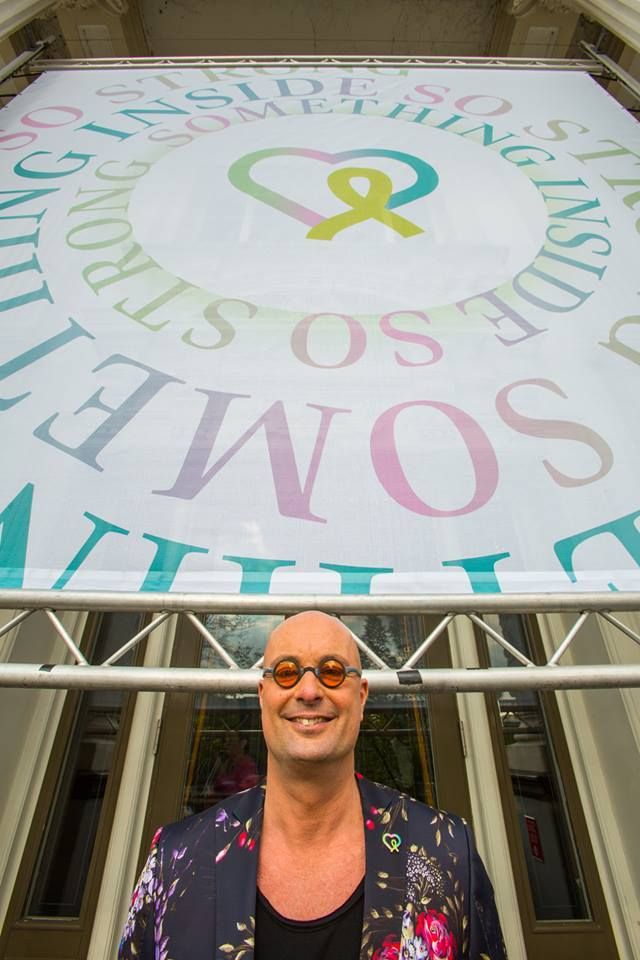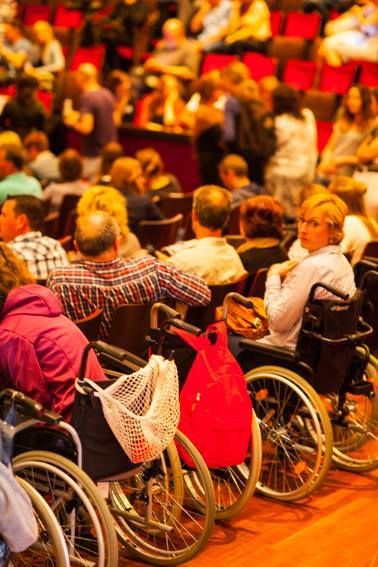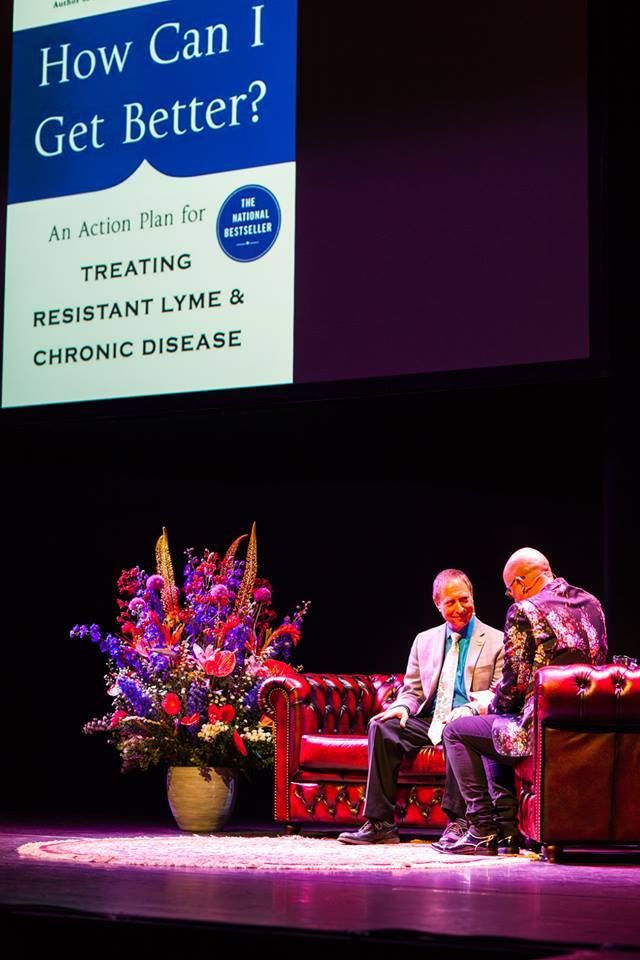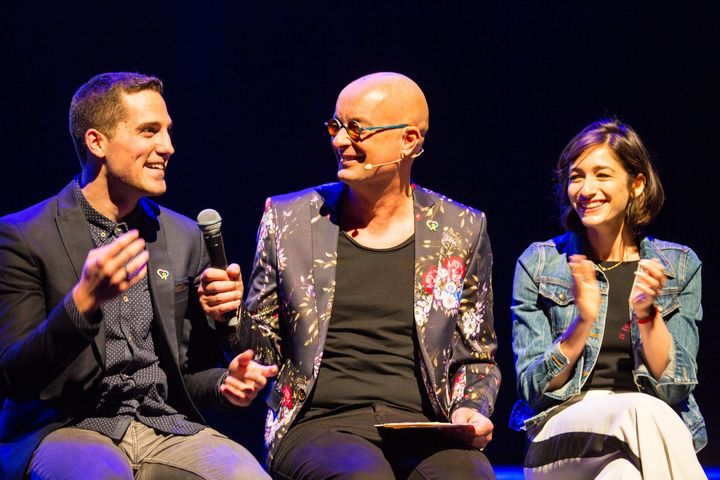
Fred Verdult, founder of Something Inside So Strong
Fred Verdult has lived with HIV since 1998, and he has been well known in his native country, the Netherlands, as a fierce advocate for HIV/AIDS patients ever since.
“I decided at once to be completely open about it so that I did not have to live with a secret,” he said.
No one wants to live with HIV, but the timing was relatively fortuitous. “I had virtually no health problems and two years before my diagnosis, an effective treatment had been found,” Verdult told me. “My life expectancy with HIV is practically normal.”
Verdult’s optimistic outlook has led him to make the most of what for many, especially in the 1990s, was a devastating diagnosis. Shortly after he found out he was HIV positive, Verdult opened Volle Maan (Full Moon), a medical communications and surveying company. His organization has won national awards in the Netherlands, and he says that Volle Maan collaborates “with all HIV-related organizations” in the country. He is an adviser on a national panel to reduce the number of new HIV infections, and “on a worldwide strategy to find a cure for HIV.”
Verdult hosts an annual World AIDS Day event at the Royal Theatre Carre in Amsterdam at which he interviews HIV patients and experts, such as Françoise Barré-Sinoussi, who won a Nobel Prize for discovering the HIV virus in 1983. Olympic champion Greg Lougainis is among the guests Verdult interviewed at the 2016 event, held last fall in Amsterdam.
I am gay, and having been born in 1978, I was a child when the AIDS epidemic was a plague and a terrifying mystery. I was an adolescent–a teenage boy growing into my sexuality–in the 90s, when HIV/AIDS was fairly well understood, and understood largely as a “gay disease.” It was terrifying. It felt like a curse. I am happy to be HIV-negative to this day, but I feel like I have a good grasp of the stigma of the disease.
That’s why I was curious to ask Verdult about something I have discussed here, something that has caused some controversy and a few complaints (all from HIV-positive people): Is it fair to say that Lyme disease in many respects is the new AIDS? He’s the right person to ask, since he too lives with Lyme disease and says that the battle for understanding, respect, and healthcare parity for Lyme patients has been a much more difficult one than HIV advocacy ever was.
Lyme disease is a bacterial infection; HIV is a virus. The ways the two infections interact with the immune system are very different, and while HIV is transmitted through bodily fluids, Lyme is primarily transmitted through tick bites. (Although it is important to note that other potentially deadly tickborne illnesses that frequently co-occur with Lyme disease, such as the malaria-like babesiosis, are readily transmitted through blood transfusions.) In short, Lyme and HIV, etiologically, are dissimilar.
Still, people who live with progressive untreated Lyme, or persisting/chronic Lyme disease following short-term treatment (called post-treatment Lyme disease syndrome, or PTLDS, by the CDC) suffer such severe health problems that they can’t function; many feel as if their bodies are shutting down. Lyme doesn’t kill people as frequently as HIV does, but it does kill. In March, a young British mother who had been diagnosed with ALS, and then later diagnosed with Lyme disease, died. The same happened in 2014 to a man in Rhode Island. Lyme also causes a condition called Lyme carditis, or heart block, that can kill a seemingly healthy young person or three in, well, a heartbeat. In 2015, Forbes suggested these cases are underreported. And then there are the deaths by suicide.
Even when Lyme disease doesn’t kill people, it takes their livelihoods away. And like HIV/AIDS patients in the 80s, many doctors refuse to have anything to do with chronic Lyme patients. The difference is that instead of saying they’re afraid of catching the disease from them, they say that these patients don’t have the disease at all.
This has been Verdult’s experience. He used to be an avid cyclist, traversing the Mediterranean and the Alps on his bicycle. Five years ago, he found a rash on his abdomen that his partner thought was shingles. His doctor said it was a rash that would probably go away, which it did. Six months later, Verdult says, “my life became a nightmare. It began with slight defects in my memory and my ability to concentrate. Every week it grew worse. Occasionally it happens that somebody’s HIV virus is effectively suppressed in the blood, but not in the brains. A professor of neurology who is specialized in HIV, could see me right away, and he had an MRI done and a lumbar puncture, but no damage or virus was found.”
His doctors told him he was overworked and to relax.
Soon, Verdult was suffering from erratic heartbeats, fatigue, and an inability to think. “The most invalidating complaint is brain fog…I lie on my couch, I vegetate and I wish that my life would end.”
Verdult’s general practitioner had no idea what was wrong with him, so his HIV specialist collaborated to solve the mystery. “In the treatment of HIV, she takes her patients’ complaints very serious, also when these are hard to measure, like fatigue.” In two and a half years, Fred says, he saw 37 doctors and his symptoms worsened. A neurology professor suggested epilepsy, multiple sclerosis and chronic carbon monoxide poisoning.
Ultimately, Verdult saw a headline that read “Worries About Suicides Among Lyme Patients” on the national Dutch newspaper De Telegraaf. He read about Lyme and asked his HIV specialist about it. She gave him a month of doxycycline, and when that didn’t cure his symptoms, she told him he doesn’t have Lyme. She was wrong.
Verdult was diagnosed with Lyme by a specialist in Germany. After several months on a combination of antibiotics, Verdult says, “my complaints had been reduced by over 90 percent.” He stopped taking the medications and relapsed within two weeks. (A personal aside: Had this not been almost me exact experience, I don’t think I’d believe any of this–such is the strange manifestation and the stigma of Lyme disease.)
Verdult is doing better under the treatment of his Lyme specialist, but he has to travel to Germany for treatment; no doctor he has found in the Netherlands will even discuss Lyme disease with him. His formerly compassionate HIV specialist “no longer takes me seriously in conversations and she avoids consultation with my German doctor, although that would be more appropriate because of the possibility of a serious interaction between my HIV meds and the antibiotics.”
Verdult is an HIV success story, having not only survived but thrived in the face of a life-altering diagnosis 18 years ago. He turned lemons into lemonade and has contributed immensely to improving the lives of other HIV patients in the Netherlands and throughout the world.
Despite all this, now that he has a pesky case of life-changing Lyme disease that won’t go away, he’s treated with disdain by the very same Dutch doctors who gave him nothing but compassion as a patient with HIV. They not only can’t help him; they don’t want to help him.
Not only do they not want to help him; they don’t want to hear about his health problems. So Verdult, like a lot of Lyme patients, has found that his country’s incredible public health system is useful for HIV and the sniffles, but draws the line at Lyme disease; he pays out of pocket to travel to and stay in Germany and out of pocket for medical expenses so that he can function and carry on with his life.

About 800 people filled the historic Royal Carre Theater in Amsterdam, many in wheelchairs, to be part of the annual Lyme disease awareness event.
Physicians, Patients and Advocates Convene in Amsterdam
In June 2015, the Netherlands National Institute for Public Health and the Environment, Ministry of Health, Welfare and Sport published the first nationwide “burden of disease” determination about Lyme. According to the institute, Lyme, “a mild disease that is contracted by many people may have the same burden of disease as a severe disease that affects a small group of people.” This, the institute says, “is caused by long-term complaints after Lyme disease.”
This controversial medical opinion that many people who are diagnosed with Lyme disease, supposedly cured fully but whose health continues to decline sometimes to full disability, is also promoted by the United States Centers for Disease Control and Prevention (CDC), which refers to the condition as “post-treatment Lyme disease syndrome,” or PTLDS. While the CDC’s website offers PTLDS care recommendations that many Lyme disease patients find condescending at best—such as “Share your feelings. If your family and friends can’t provide the support you need, talk with a counselor who can help you find ways of managing your life during this difficult time.”—the agency’s site now also postulates that the ongoing symptoms may be due to permanent nerve damaged or auto-immune diseases caused by the infection.
On May 22, Fred Verdult hosted Something Inside So Strong, an event in Amsterdam to raise awareness about Lyme disease, modeled on his annual HIV event, which fills a national theatre with over 800 people each year. Just as he refused to succumb to either the illness or the shame of it nearly 20 years ago when he was diagnosed with HIV, Verdult is not backing down when he’s told that Lyme–which he says has made him far more ill than HIV ever has–is no big deal, or all in his head.

Patients and their loved ones came from throughout the Netherlands for the event. Here, a young woman with Lyme who sprawls out on the floor of the Royal Carre Theatre with the support of friends.
HIV is one of the deadliest diseases the human race has ever battled. And the battle rages on. But the lessons of the AIDS crisis are more than the disease: Lessons should have been taken from the response to the disease. It was terrible. It was inhumane. Sick and dying people were rejected by medical professionals who didn’t understand the disease and who stubbornly held onto outdated, false information even after viable treatments were being found. Guest on national talk shows chastised, laughed at and shamed AIDS patients, and it only turned around when people collectively decided that this was wrong. This happens today to patients who have Lyme disease, a poorly understood and life-altering illness. Lyme disease activists view the HIV/AIDS success story—overcoming the inhumanities and medical enigma—as being an example of the collective power of humanity to overcome mortal threats and to overcome biases and bigotry. Lyme activists don’t understand why these lessons aren’t applied to the Lyme disease epidemic.
“A Great Injustice”

Dr. Elena Frid with Verdult
Among those who Verdult interviewed during his event was one of his own doctors, Elena Frid, a neurologist and neurophysiologist based in New York. She describes the way Lyme disease patients are neglected and dismissed by the medical community as “a great injustice.” In her practice, Frid has noticed that patients with Lyme disease frequently are misdiagnosed with other neurological or even psychiatric illnesses, which end up being treatable with antibiotics.
“MS, ALS, Parkinson’s disease and various dementias,” she has said. “We’ve had an explosion of Alzheimer’s and dementias in the last 30 to 40 years in North America. Why is that going on? Perhaps not 100 percent of these patients have infections, but a significant part of them do. Is it even possible to consider that potentially these conditions can be reversible? Neuropsychiatric problems such as anxiety, depression, paranoia, mood disorders, thought disorders. One in five people across the world are on psychotropic medications,” Frid say, suggesting that more patients with these symptoms should be evaluated for infectious and inflammatory diseases rather than discarded.
To those unfamiliar with Lyme disease, Frid’s comments may sound unlikely to extreme. Yet neuropsychiatric symptoms of Lyme disease are common—just as they are among patients of Lyme’s bacterial cousin syphilis—to such an extent that many high-profile cases exist. Author Amy Tan reported hallucinations so real to her that she couldn’t differentiate them from reality—until she was treated with antibiotics. Kris Kristofferson was diagnosed with terminal Alzheimer’s disease, later to be properly diagnosed with Lyme, treated with antibiotics, and all his supposed Alzheimer’s symptoms reversed. Avril Lavigne on Good Morning America couldn’t hold back tears as she said that doctors told her she was “crazy” and not ill at all, until she was diagnosed and treated for Lyme.
And then there are the unfamous cases, such as David Geraghty, a school teacher who was diagnosed and died from ALS, which at his wife’s urging ultimately was correctly attributed to Lyme disease. This former dancer saw over 100 doctors before she was diagnosed with and treated for Lyme. And yet doctors who treat Lyme patients worldwide continue to be persecuted for doing so—even as patients who had been otherwise abandoned say that these doctors save their lives. Daryl Hall of Hall and Oats had similar symptoms dismissed and ultimately was diagnosed with Lyme; he calls the dismissal of Lyme patients by doctors “a scandal.”
While American Lyme patients lament challenges in accessing diagnosis and treatment for Lyme disease in the United States, our healthcare system is a beacon of hope for patients such as Verdult, whose public healthcare system altogether denies access to treatment. Verdult benefited from the excellent care offered for HIV by the Dutch healthcare system, but when he was diagnosed with Lyme, he was told that the diagnosis is invalid. His health has improved with treatment—but that treatment comes at a great cost, requiring financial and time investments to travel to the United States and to pay out of pocket for premium treatment by highly specialized physicians, and the medications necessary to treat his illness.
Verdult’s event was convened in partnership with Run for Lyme, which raised over a half million Euros to fund Dutch Lyme disease patients’ international travels to access Lyme treatment. One patient set a goal of 3,000 Euros to seek treatment in Poland; when he raised several times his goal, he shared the money with other Lyme patients so that they could travel together in the hope of finding help.
Other Dutch patients have not been so fortunate, developing the characteristic agonizing pain and disability of persisting Lyme disease, and often selling off their possessions and moving in with family simply to access medical care. This also happens within the United States, where high-quality healthcare requires premium medical insurance or vast financial reserves—but our private healthcare system at least offers patients (within the United States and throughout the world) to pursue treatment when necessary. In all-or-nothing public healthcare systems such as those the Netherlands, the United Kingdom, Canada and Australia, patients don’t have the luxury of shopping around—they either live with the consequences of untreated illness, or they find a way to get to the U.S. or Germany, where financial incentives and high Lyme disease incidence motivate some doctors to become de-facto medical investigators and tickborne disease specialists.

Dr. Richard Horowitz with Fred Verdult
He Wrote the Books on Lyme Disease
Richard Horowitz received a standing ovation when he took the stage in Amsterdam. Horowitz, an internal medicine specialist who has published two books about Lyme disease and chronic illness, operates a clinic in New York that has treated over 12,000 patients for tickborne diseases.
“The magic of mixing art, dance, storytelling, music, and medicine into a large public awareness event in a Royal theatre was a once in a lifetime experience,” Horowitz said after the event. “Bravo, Fred. You really know how to raise awareness, and give people hope and healing.”
As a pioneer in Lyme medicine, Horowitz is intimately familiar with the disease’s refusal to play by rulebooks, or in accordance with existing medical textbooks. Horowitz’s new book, How Can I Get Better? discusses Lyme testing and treatment as well as a thorough overview of Lyme MSIDS and the many ways by which it can cause the body to go haywire.
Many people believe that the term “chronic Lyme disease” is too charged with stigma, too contentious, and that using a different term could change the tide of bias that pushes against the Lyme community. Horowitz coined the term “MSIDS,” or multi-systemic infectious disease syndrome, a less specific term that accounts not only for the Borrelia burgdorferi and B. mayonii bacteria that cause Lyme disease, but also for other common infections spread by ticks (such as Borrelia miyamotoi, B. afzelli and B. garinii et al.; Babesia microti, anaplasma, erlichia, and potentially Bartonella henselae).
Horowitz’s term also differentiates acute Lyme disease infections caused by B. burgdorferi from the persistent Lyme symptoms that affect many Lyme disease patients even following treatment; while the diseases are nothing alike, HIV being a virus and Borrelia a bacterium, Horowitz’s notion of Lyme vs. MSIDS is comparable to that of HIV vs. AIDS: HIV is the virus that when unmanaged causes autoimmune deficiency syndrome, and Lyme is the bacterium that when unmanaged causes multi-systemic infectious disease syndrome. Borrelia bacteria are known to cause dermatological, neurological and sometimes cardiovascular symptoms—but in many Lyme patients, even more bodily systems are seriously affected, and specialists such as Horowitz manage symptoms holistically, as a whole-body illness. He is currently developing a computer and mobile application to help doctors unfamiliar with Lyme disease make proper differential diagnoses so that patients will stand a greater chance of more rapid diagnosis.
“In my opinion,” Verdult told me, the similarity “between the efforts of society to beat HIV and the way society deals with Lyme is even bigger than I thought.” But, he said, “research in prestigious universities is hopeful.”
Research is vital to understanding what exactly chronic/persisting Lyme disease/PTLDS is and how to treat it. On this side of the Atlantic, there’s a great disparity in public funding for Lyme research compared with other diseases of similar severity and far lesser prevalence.
The Healing Power of the Arts
The Dutch event was a remarkable combination of medical science and performing arts.
“I had never seen or experienced a multimedia event like this,” Horowitz said. “I was so moved by what I had experienced, I wasn’t sure it was going to be easy to not break down on stage, my heart was so open and raw.”
Jesse Ruben is a New York-based musician whose life has been profoundly affected by Lyme disease. He played several songs, one of which struck me to my core as he sung about trying to sleep “while my bones are burning”—a crushing feeling that has awaken me from sleep on countless nights—and discussed his story with Verdult. As he became sicker and sicker, saw doctor after doctor and got fewer answers with each visit, his mother and his girlfriend—Jen Jacob, who was also interviewed onstage by Verdult—encouraged him to manage his depression by seeing a psychiatrist. Jacob waited in the car while Ruben went in for his first counseling session. When he came out, he said, “OK, I did it. Now I need you to understand that I am sick and this isn’t going to fix it.”
“OK,” Jacob said. “Then we need to find a doctor who can fix you.”

From left: Jesse Ruben, Fred Verdult, Jen Jacob
Eventually Ruben was diagnosed with Lyme disease, treated, and he recovered his health. The process of recovery, he and Jacob explained, was both physically and emotionally tumultuous. Ruben said he was lucky to have had the support of his fiercely loyal and supportive girlfriend throughout the ordeal—but that one source of conflict between the two of them was her inability to relate to what he was going through as much as she tried.
Ruben found a support group for Lyme disease patients, and there he found people who understood the bizarre constellation of symptoms that aren’t know to most people. As he became closer with other Lyme patients, his girlfriend had to understand that she needed to “step back” and give Ruben time and space with other people who could serve a role in his life that she could not. Giving him this space ultimately brought them closer together.
After Ruben had recovered significantly, he made a difficult confession to Jacob: the ordeal had been so arduous that, now that he was feeling better physically, he had been thrown into a depression and felt he needed therapy.

Louise Vd Sande Bakhuyzen (at piano) and Lidewij Boeken (singing)

Perry Dossett and Manon Prins perform
Back in the USA
By all accounts, the United States of America has the greatest rate of Lyme disease infections worldwide, with an estimated 320,000 new infections annually according to the CDC. With the majority of known infections occurring from Washington, D.C. northward up the east coast of the U.S., many of the world’s preeminent Lyme disease specialists, including Horowitz, practice in New York.
Dr. Elena Frid recently dedicated her practice to Lyme disease patients after she saw a tremendous number of patients hospitalized with mysterious symptoms that turned out to be due to Lyme disease. She discussed her motivations with local New York City news station FOX5NY, which recently won an Emmy Award for its 2016 television special Lyme and Reason.
Following the 2017 Something Inside So Strong event, Verdult wrote this on Facebook (translated roughly from Dutch):
Lyme lives matter! We demand nothing special, but just that the care and medication for our disease! Anyone can get Lyme tomorrow. An important part of so strong I believe the focus for the battle of Marika Bazelmans along with her mother Ellen and lawyer to Charlotte combée her Lyme Treatment. The judge has ruled that the health care insurer Marika's treatment by a foreign doctor should reimburse. If this appeal verdict stands, others will also be able to access treatment.
A snapshot of Lyme in the Netherlands from Verdult’s 2016 Something Inside So Strong event:
